YAMAHA TMAX 2001 Repair Manual
Manufacturer: YAMAHA, Model Year: 2001, Model line: TMAX, Model: YAMAHA TMAX 2001Pages: 100, PDF Size: 1.61 MB
Page 61 of 100
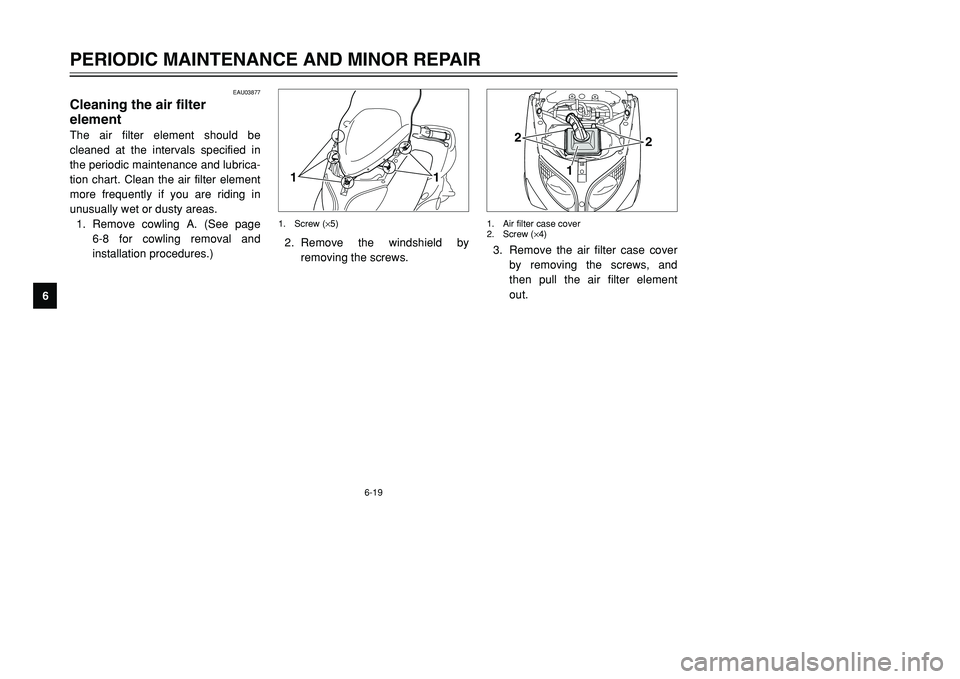
6-19
PERIODIC MAINTENANCE AND MINOR REPAIR
1
2
3
4
56
7
8
9
EAU03877
Cleaning the air filter
elementThe air filter element should be
cleaned at the intervals specified in
the periodic maintenance and lubrica-
tion chart. Clean the air filter element
more frequently if you are riding in
unusually wet or dusty areas.
1. Remove cowling A. (See page
6-8 for cowling removal and
installation procedures.)
1
1
2. Remove the windshield by
removing the screws.1. Screw (×5)
1
2
2
3. Remove the air filter case cover
by removing the screws, and
then pull the air filter element
out.1. Air filter case cover
2. Screw (×4)
5GJ-9-EV 5/26/01 11:04 AM Page 60
Page 62 of 100
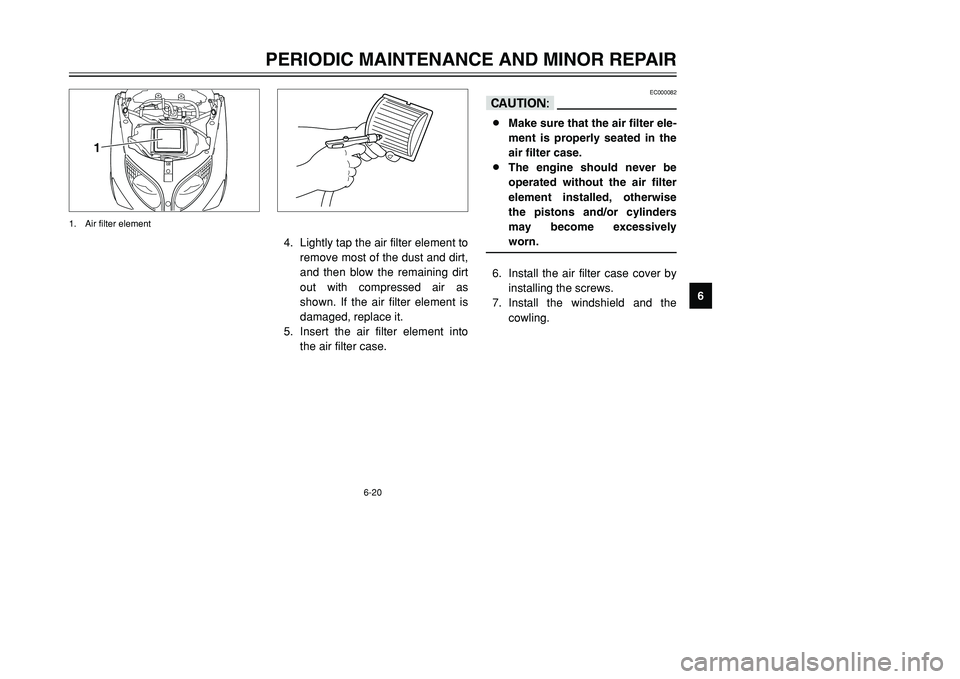
6-20
PERIODIC MAINTENANCE AND MINOR REPAIR
1
2
3
4
56
7
8
9
EC000082
cC8Make sure that the air filter ele-
ment is properly seated in the
air filter case.
8The engine should never be
operated without the air filter
element installed, otherwise
the pistons and/or cylinders
may become excessively
worn.6. Install the air filter case cover by
installing the screws.
7. Install the windshield and the
cowling. 4. Lightly tap the air filter element to
remove most of the dust and dirt,
and then blow the remaining dirt
out with compressed air as
shown. If the air filter element is
damaged, replace it.
5. Insert the air filter element into
the air filter case.
1
1. Air filter element
5GJ-9-EV 5/26/01 11:04 AM Page 61
Page 63 of 100

6-21
PERIODIC MAINTENANCE AND MINOR REPAIR
1
2
3
4
56
7
8
9
EAU00630
Adjusting the carburetorsThe carburetors are important parts
of the engine and require very
sophisticated adjustment. Therefore,
most carburetor adjustments should
be left to a Yamaha dealer, who has
the necessary professional knowl-
edge and experience. The adjust-
ment described in the following sec-
tion, however, may be serviced by
the owner as part of routine mainte-
nance.
EC000095
cCThe carburetors have been set and
extensively tested at the Yamaha
factory. Changing these settings
without sufficient technical knowl-
edge may result in poor perfor-
mance of or damage to the engine.
EAU03821
Adjusting the engine idling
speedThe engine idling speed must be
checked and, if necessary, adjusted
as follows at the intervals specified in
the periodic maintenance and lubrica-
tion chart.NOTE:
A diagnostic tachometer is needed to
make this adjustment.1. Remove panel B. (See page 6-7
for panel removal and installation
procedures.)
2. Attach the tachometer to the
spark plug lead.
3. Start the engine and warm it up
for several minutes at
1,000–2,000 r/min while occa-
sionally revving it to 4,000–5,000
r/min.
NOTE:
The engine is warm when it quickly
responds to the throttle.4. Check the engine idling speed
and, if necessary, adjust it to
specification by turning the throt-
tle stop screw. To increase the
engine idling speed, turn the
screw in direction a. To
decrease the engine idling
speed, turn the screw in direction
b.
1a
b
1. Throttle stop screw
Engine idling speed:
1,150–1,200 r/min
5GJ-9-EV 5/26/01 11:04 AM Page 62
Page 64 of 100
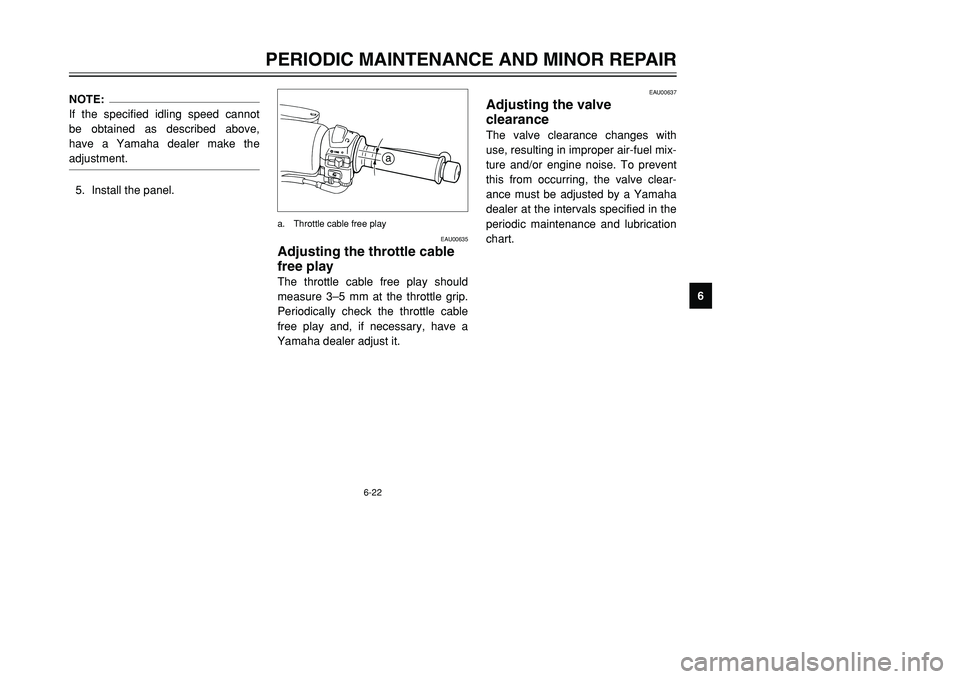
6-22
PERIODIC MAINTENANCE AND MINOR REPAIR
1
2
3
4
56
7
8
9
EAU00637
Adjusting the valve
clearanceThe valve clearance changes with
use, resulting in improper air-fuel mix-
ture and/or engine noise. To prevent
this from occurring, the valve clear-
ance must be adjusted by a Yamaha
dealer at the intervals specified in the
periodic maintenance and lubrication
chart.
NOTE:
If the specified idling speed cannot
be obtained as described above,
have a Yamaha dealer make the
adjustment.5. Install the panel.
EAU00635
Adjusting the throttle cable
free playThe throttle cable free play should
measure 3–5 mm at the throttle grip.
Periodically check the throttle cable
free play and, if necessary, have a
Yamaha dealer adjust it.
a
a. Throttle cable free play
5GJ-9-EV 5/26/01 11:04 AM Page 63
Page 65 of 100
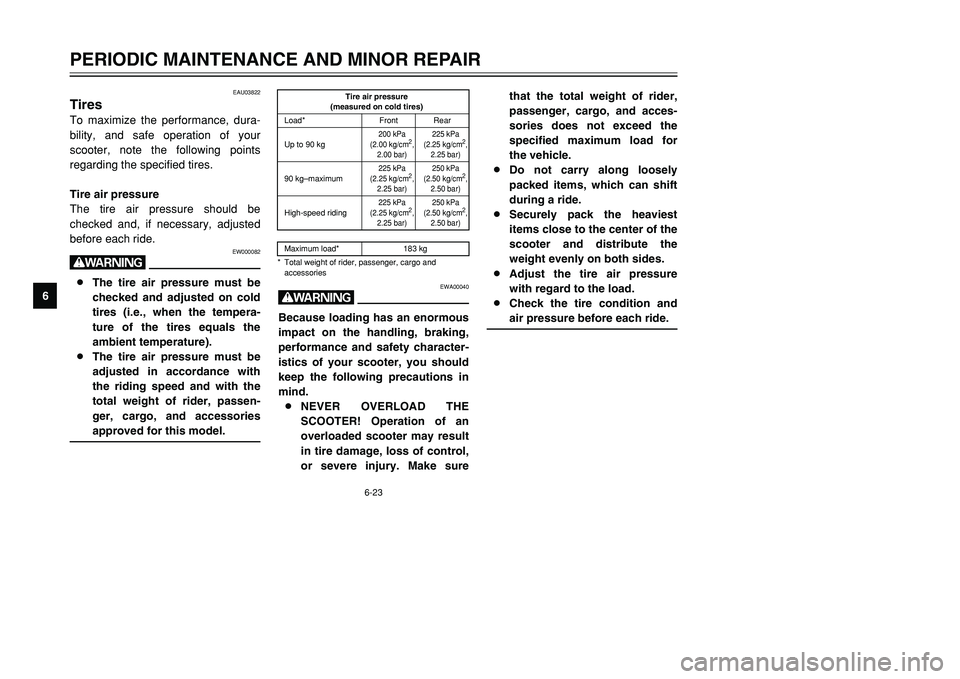
6-23
PERIODIC MAINTENANCE AND MINOR REPAIR
1
2
3
4
56
7
8
9
EAU03822
TiresTo maximize the performance, dura-
bility, and safe operation of your
scooter, note the following points
regarding the specified tires.
Tire air pressure
The tire air pressure should be
checked and, if necessary, adjusted
before each ride.
EW000082
w8The tire air pressure must be
checked and adjusted on cold
tires (i.e., when the tempera-
ture of the tires equals the
ambient temperature).
8The tire air pressure must be
adjusted in accordance with
the riding speed and with the
total weight of rider, passen-
ger, cargo, and accessories
approved for this model.
EWA00040
wBecause loading has an enormous
impact on the handling, braking,
performance and safety character-
istics of your scooter, you should
keep the following precautions in
mind.
8NEVER OVERLOAD THE
SCOOTER! Operation of an
overloaded scooter may result
in tire damage, loss of control,
or severe injury. Make sure
Tire air pressure
(measured on cold tires)
Load* Front Rear
Up to 90 kg
200 kPa
(2.00 kg/cm
2,
2.00 bar)225 kPa
(2.25 kg/cm
2,
2.25 bar)
90 kg–maximum
225 kPa
(2.25 kg/cm
2,
2.25 bar)250 kPa
(2.50 kg/cm
2,
2.50 bar)
High-speed riding
225 kPa
(2.25 kg/cm
2,
2.25 bar)250 kPa
(2.50 kg/cm
2,
2.50 bar)
Maximum load* 183 kg
* Total weight of rider, passenger, cargo and
accessories
that the total weight of rider,
passenger, cargo, and acces-
sories does not exceed the
specified maximum load for
the vehicle.
8Do not carry along loosely
packed items, which can shift
during a ride.
8Securely pack the heaviest
items close to the center of the
scooter and distribute the
weight evenly on both sides.
8Adjust the tire air pressure
with regard to the load.
8Check the tire condition and
air pressure before each ride.
5GJ-9-EV 5/26/01 11:04 AM Page 64
Page 66 of 100

6-24
PERIODIC MAINTENANCE AND MINOR REPAIR
1
2
3
4
56
7
8
9
1a
Tire inspection
The tires must be checked before
each ride. If the center tread depth
reaches the specified limit, if the tire
has a nail or glass fragments in it, or
if the side wall is cracked, have a
Yamaha dealer replace the tire imme-
diately.NOTE:
The tire tread depth limits may differ
from country to country. Always com-
ply with the local regulations.1. Tire sidewall
a. Tire tread depth
EW000079
w8Have a Yamaha dealer replace
excessively worn tires.
Besides being illegal, operat-
ing the scooter with exces-
sively worn tires decreases
riding stability and can lead to
loss of control.
8The replacement of all wheel-
and brake-related parts,
including the tires, should be
left to a Yamaha dealer, who
has the necessary profession-
al knowledge and experience.
Tire information
This scooter is equipped with cast
wheel and tubeless tires.
EW000078
w8The front and rear tires should
be of the same make and
design, otherwise the handling
characteristics of the scooter
cannot be guaranteed.
8After extensive tests, only the
tires listed below have been
approved for this model by
Yamaha Motor Co., Ltd.
Minimum tire tread depth
(front and rear)1.6 mm
FRONT
Manufacturer Size Model
DUNLOP 120/70-14M/C 55S D305FABRIDGESTONE
120/70-14M/C 55S HOOP B03
REAR
Manufacturer Size Model
DUNLOP 150/70-14M/C 66S D305
BRIDGESTONE
150/70-14M/C 66S HOOP B02
5GJ-9-EV 5/26/01 11:04 AM Page 65
Page 67 of 100
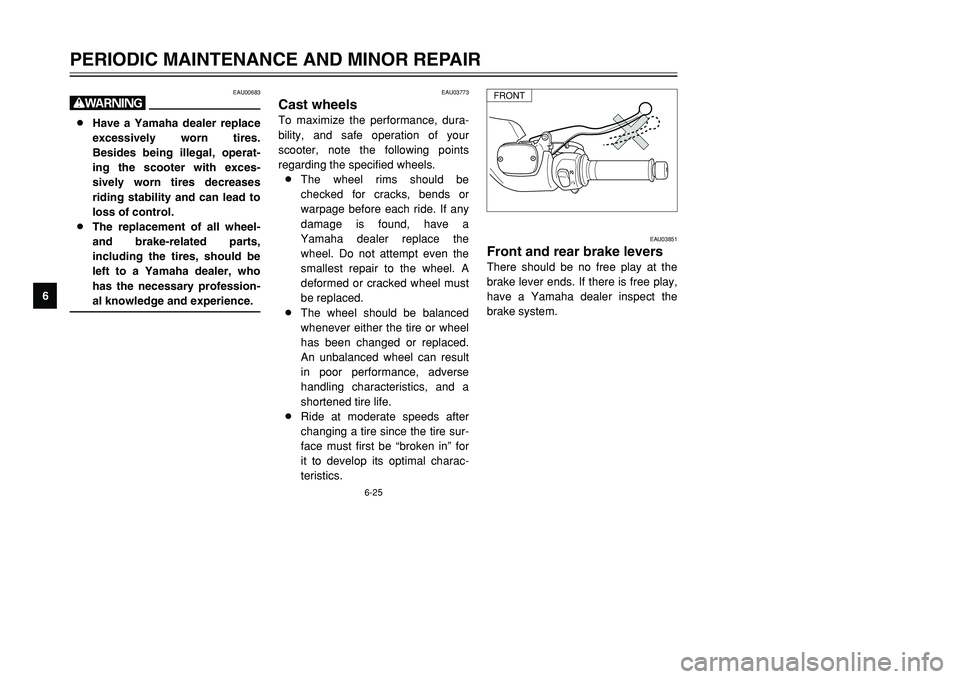
6-25
PERIODIC MAINTENANCE AND MINOR REPAIR
1
2
3
4
56
7
8
9
EAU03773
Cast wheelsTo maximize the performance, dura-
bility, and safe operation of your
scooter, note the following points
regarding the specified wheels.
8The wheel rims should be
checked for cracks, bends or
warpage before each ride. If any
damage is found, have a
Yamaha dealer replace the
wheel. Do not attempt even the
smallest repair to the wheel. A
deformed or cracked wheel must
be replaced.
8The wheel should be balanced
whenever either the tire or wheel
has been changed or replaced.
An unbalanced wheel can result
in poor performance, adverse
handling characteristics, and a
shortened tire life.
8Ride at moderate speeds after
changing a tire since the tire sur-
face must first be “broken in” for
it to develop its optimal charac-
teristics.
EAU03851
Front and rear brake leversThere should be no free play at the
brake lever ends. If there is free play,
have a Yamaha dealer inspect the
brake system.
EAU00683
w8Have a Yamaha dealer replace
excessively worn tires.
Besides being illegal, operat-
ing the scooter with exces-
sively worn tires decreases
riding stability and can lead to
loss of control.
8The replacement of all wheel-
and brake-related parts,
including the tires, should be
left to a Yamaha dealer, who
has the necessary profession-
al knowledge and experience.
FRONT
5GJ-9-EV 5/26/01 11:04 AM Page 66
Page 68 of 100
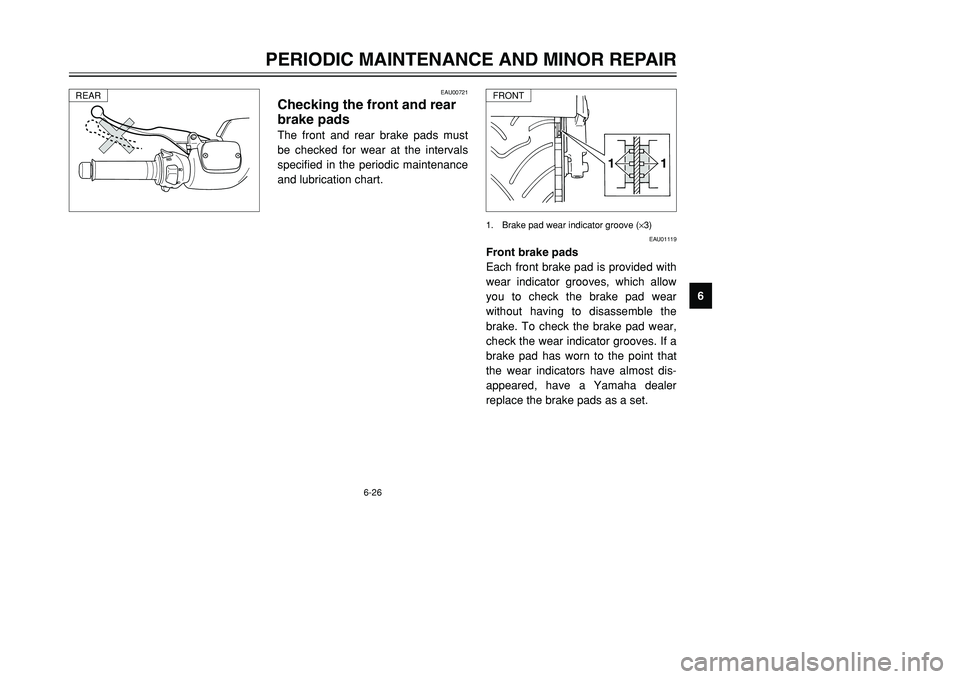
6-26
PERIODIC MAINTENANCE AND MINOR REPAIR
1
2
3
4
56
7
8
9
1 11 1
1. Brake pad wear indicator groove (×3)
EAU00721
Checking the front and rear
brake padsThe front and rear brake pads must
be checked for wear at the intervals
specified in the periodic maintenance
and lubrication chart.
EAU01119
Front brake pads
Each front brake pad is provided with
wear indicator grooves, which allow
you to check the brake pad wear
without having to disassemble the
brake. To check the brake pad wear,
check the wear indicator grooves. If a
brake pad has worn to the point that
the wear indicators have almost dis-
appeared, have a Yamaha dealer
replace the brake pads as a set.
REAR
FRONT
5GJ-9-EV 5/26/01 11:04 AM Page 67
Page 69 of 100
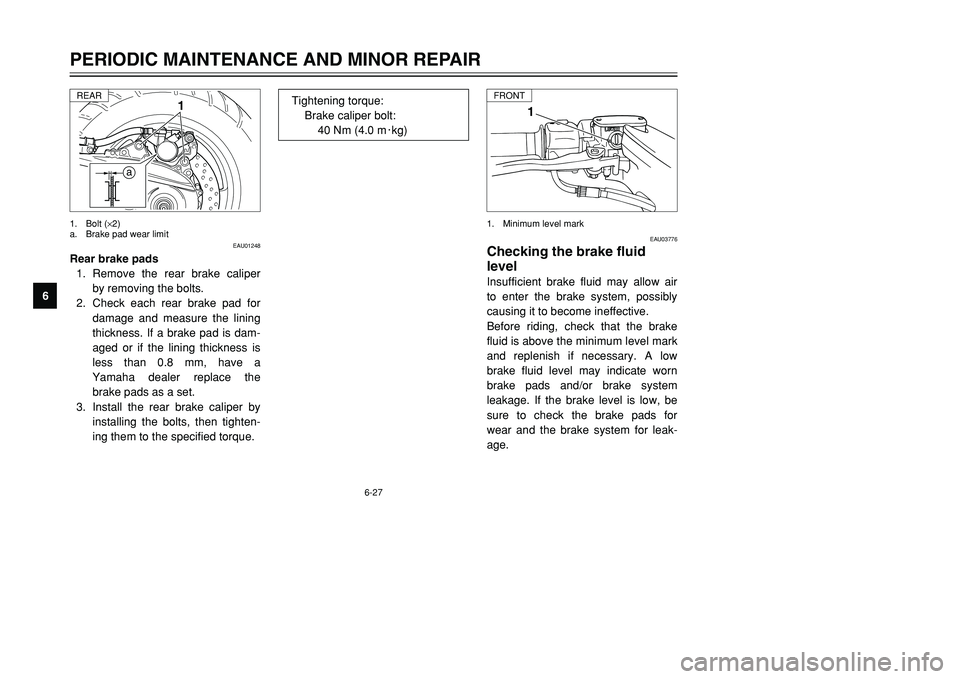
6-27
PERIODIC MAINTENANCE AND MINOR REPAIR
1
2
3
4
56
7
8
9
1
EAU03776
Checking the brake fluid
levelInsufficient brake fluid may allow air
to enter the brake system, possibly
causing it to become ineffective.
Before riding, check that the brake
fluid is above the minimum level mark
and replenish if necessary. A low
brake fluid level may indicate worn
brake pads and/or brake system
leakage. If the brake level is low, be
sure to check the brake pads for
wear and the brake system for leak-
age.1. Minimum level mark
a1
EAU01248
Rear brake pads
1. Remove the rear brake caliper
by removing the bolts.
2. Check each rear brake pad for
damage and measure the lining
thickness. If a brake pad is dam-
aged or if the lining thickness is
less than 0.8 mm, have a
Yamaha dealer replace the
brake pads as a set.
3. Install the rear brake caliper by
installing the bolts, then tighten-
ing them to the specified torque.1. Bolt (×2)
a. Brake pad wear limit
Tightening torque:
Brake caliper bolt:
40 Nm (4.0 m0kg)
FRONT
REAR
5GJ-9-EV 5/26/01 11:04 AM Page 68
Page 70 of 100
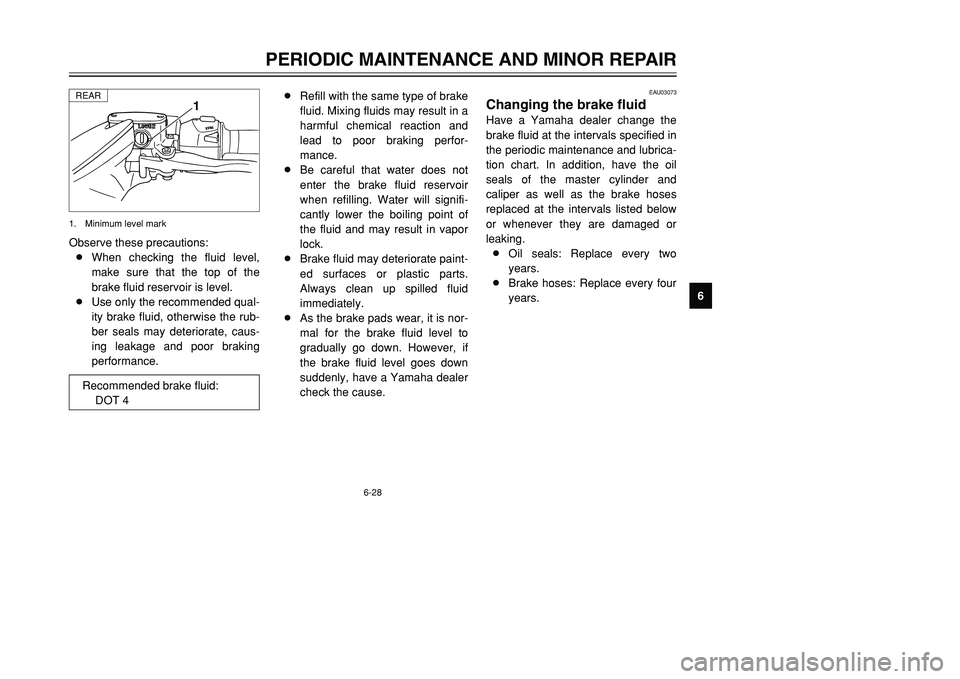
6-28
PERIODIC MAINTENANCE AND MINOR REPAIR
1
2
3
4
56
7
8
9 Recommended brake fluid:
DOT 4
1
Observe these precautions:
8When checking the fluid level,
make sure that the top of the
brake fluid reservoir is level.
8Use only the recommended qual-
ity brake fluid, otherwise the rub-
ber seals may deteriorate, caus-
ing leakage and poor braking
performance.1. Minimum level mark
8Refill with the same type of brake
fluid. Mixing fluids may result in a
harmful chemical reaction and
lead to poor braking perfor-
mance.
8Be careful that water does not
enter the brake fluid reservoir
when refilling. Water will signifi-
cantly lower the boiling point of
the fluid and may result in vapor
lock.
8Brake fluid may deteriorate paint-
ed surfaces or plastic parts.
Always clean up spilled fluid
immediately.
8As the brake pads wear, it is nor-
mal for the brake fluid level to
gradually go down. However, if
the brake fluid level goes down
suddenly, have a Yamaha dealer
check the cause.
EAU03073
Changing the brake fluidHave a Yamaha dealer change the
brake fluid at the intervals specified in
the periodic maintenance and lubrica-
tion chart. In addition, have the oil
seals of the master cylinder and
caliper as well as the brake hoses
replaced at the intervals listed below
or whenever they are damaged or
leaking.
8Oil seals: Replace every two
years.
8Brake hoses: Replace every four
years.
REAR
5GJ-9-EV 5/26/01 11:04 AM Page 69